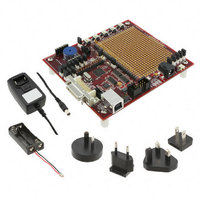EM260-BBRD-128K-USART-R Ember, EM260-BBRD-128K-USART-R Datasheet - Page 23

EM260-BBRD-128K-USART-R
Manufacturer Part Number
EM260-BBRD-128K-USART-R
Description
EM260 BREAKOUT BOARD
Manufacturer
Ember
Type
Transceiver, 802.15.4/ZigBeer
Datasheet
1.EM260-RCM-USART-R.pdf
(54 pages)
Specifications of EM260-BBRD-128K-USART-R
Frequency
2.4GHz
For Use With/related Products
EM260
Lead Free Status / RoHS Status
Lead free / RoHS Compliant
Other names
636-1026
5.2.1
The Host begins the transaction by asserting the Slave Select and then sending a command to the EM260. This
command can be of any length from 2 to 136 bytes and must not begin with
section, the EM260 will respond with only
section. Once the Host has completed transmission of the entire message, the transaction moves to the Wait
section.
5.2.2
The Wait section is a period of time during which the EM260 may be processing the command or performing
other operations. Note that this section can be any length of time up to 200 milliseconds. Because of the
variable size of the Wait section, an interrupt-driven or polling-driven method is suggested for clocking the SPI
as opposed to a DMA method. Since the EM260 can require up to 200 milliseconds to respond, as long as the
Host keeps Slave Select active, the Host can perform other tasks while waiting for a Response.
To determine when a Response is ready, use one of two methods:
•
•
The first method, clocking the SPI, is recommended due to simplicity in implementing. During the Wait
section, the EM260 will transmit only
the EM260 transmits a byte other than
Therefore, the Host can poll for a Response by continuing to clock the SPI by transmitting
the EM260 to transmit a byte other than
asserting the nHOST_INT signal. The falling edge of nHOST_INT is the indication that a Response is ready. Once
the nHOST_INT signal asserts, nHOST_INT will return to idle after the Host begins to clock data.
5.2.3
When the EM260 transmits a byte other than
section. The data format is the same format used in the Command section. The response can be of any length
from 2 to 136 bytes and will not begin with
response is known from the first or second byte and this length should be used by the Host to clock out exactly
the correct number of bytes. Once all bytes have been clocked, it is allowable for the Host to deassert chip
select. Since the Host is in control of clocking the SPI, there are no ACKs or similar signals needed back from
the Host because the EM260 will assume the Host could accept the bytes being clocked on the SPI. After every
transaction, the Host must hold the Slave Select high for a minimum of 1ms. This timing requirement is called
the inter-command spacing and is necessary to allow the EM260 to process a command and become ready to
accept a new command.
5.2.4
When the EM260 has data to send to the Host, it will assert the nHOST_INT signal. The nHOST_INT signal is
designed to be an edge-triggered signal as opposed to a level-triggered signal; therefore, the falling edge of
nHOST_INT is the true indicator of data availability. The Host then has the responsibility to initiate a
transaction to ask the EM260 for its output. The Host should initiate this transaction as soon as possible to
prevent possible backup of data in the EM260. The EM260 will deassert the nHOST_INT signal after receiving a
byte on the SPI. Due to inherent latency in the EM260, the timing of when the nHOST_INT signal returns to idle
can vary between transactions. nHOST_INT will always return to idle for a minimum of 10us before asserting
again. If the EM260 has more output available after the transaction has completed, the nHOST_INT signal will
assert again after Slave Select is deasserted and the Host must make another request.
Clock the SPI until the EM260 transmits a byte other than
Interrupt on the falling edge of nHOST_INT.
Command Section
Wait Section
Response Section
Asynchronous Signaling
0xFF
0xFF
0xFF
0xFF
Page 23
and will ignore all incoming data until the Response is ready. When
, the transaction has officially moved into the Response section.
0xFF
0xFF
. The EM260 will also indicate that a Response is ready by
. The Host should ignore data on MISO during the Command
. Depending on the actual response, the length of the
, the transaction has officially moved into the Response
0xFF
.
0xFF
. During the Command
0xFF
and waiting for
EM260
120-0260-000J























